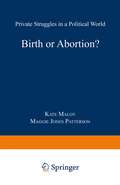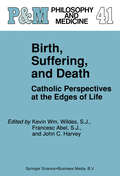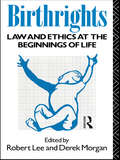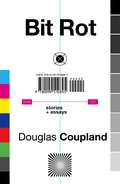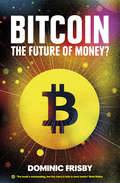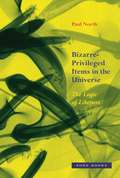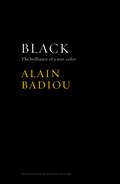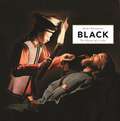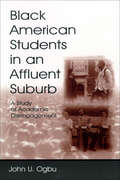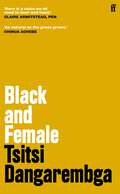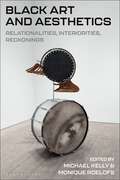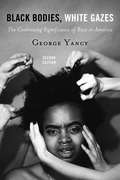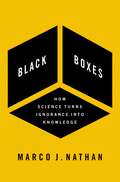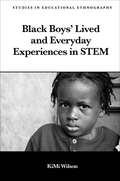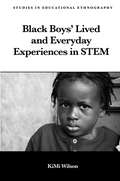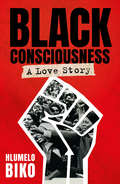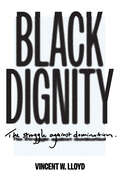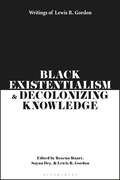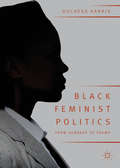- Table View
- List View
Birth, Suffering, and Death: Catholic Perspectives at the Edges of Life (Philosophy and Medicine #41)
by H. T. EngelhardtFor centuries the Roman Catholic Church has been concerned with the moral implications of medical practice. Indeed, until two decades ago, Catholic moral theologians were the major source of moral guidance, scholarly reflection and teaching on a variety of medical-moral topics, particularly those bearing on human life. Many, not only those within the Catholic communion, turned to the Church for guidance as each new possibility for altering the conditions of human life posed new challenges to long held moral values. Two decades ago, the center of gravity of ethical reflection shifted sharply from theologians and Christian philosophers to more secular thinkers. A confluence of forces was responsible for this metamorphosi- an exponential rate of increase in medical technologies, expanded education of the public, the growth of participatory democracy, the entry of courts and legislation into what had previously been private matters, the trend of morality towards pluralism and individual freedom and the depreciation of church and religious doctrines generally. Most significant was the entry of professional philosophers into the debate, for the first time. It is a curious paradox that, until the mid-sixties, professional philosophers largely ignored medical ethics. Today they are the most influential shapers of public and professional opinion.
Birthrights: Law and Ethics at the Beginnings of Life
by Robert Lee Derek MorganFirst published in 2004. Routledge is an imprint of Taylor & Francis, an informa company.
Birthrights: Law and Ethics at the Beginnings of Life
by Robert Lee Derek MorganFirst published in 2004. Routledge is an imprint of Taylor & Francis, an informa company.
Bit Rot
by Douglas CouplandIn Bit Rot, Douglas Coupland explores the different ways in which twentieth-century notions of the future are being shredded, and creates a gem of the digital age. Reading the stories and essays in Bit Rot is like bingeing on Netflix . . . you can't stop with just one.‘Bit rot’ is a term used in digital archiving to describe the way digital files can spontaneously and quickly decompose. As Coupland writes, ‘bit rot also describes the way my brain has been feeling since 2000, as I shed older and weaker neurons and connections and enhance new and unexpected ones’. Bit Rot the book explores the ways humanity tries to make sense of our shifting consciousness. Coupland, just like the Internet, mixes forms to achieve his ends. Short fiction is interspersed with essays on all aspects of modern life. The result is addictively satisfying for Coupland’s legion of fans hungry for his observations about our world. For almost three decades, his unique pattern recognition has powered his fiction, and his phrase-making. Every page of Bit Rot is full of wit, surprise and delight.
Bitcoin: The Future of Money?
by Dominic FrisbyFollowing the economic crisis of 2008, the website ‘bitcoin.org’ was registered by a mysterious computer programmer called Satoshi Nakamoto. A new form of money was born: electronic cash. Does Bitcoin have the potential to change how the world transacts financially? Or is it just a passing fad, even a major scam?In Bitcoin: The Future of Money?, MoneyWeek’s Dominic Frisby's explains this controversial new currency and how it came about, interviewing some of the key players in its development while casting light on its strange and murky origins, in particular the much-disputed identity of Nakamoto himself. Economic theory meets whodunnit mystery in this indispensable guide to one of the most divisive innovations of our time.
Bizarre-Privileged Items in the Universe: The Logic of Likeness
by Professor Paul NorthAn imaginative new theory of likeness that ranges widely across history and subjects, from physics and evolution to psychology, language, and artA butterfly is like another butterfly. A butterfly is also like a leaf and at the same time like a paper airplane, an owl’s face, a scholar flying from book to book. The most disparate things approach one another in a butterfly, the sort of dense nodule of likeness that Roger Caillois once proposed calling a “bizarre-privileged item.” In response, critical theorist Paul North proposes a spiritual exercise: imagine a universe made up solely of likenesses. There are no things, only traits acting according to the law of series, here and there a thick overlap that appears “bizarre.”Centuries of thought have fixated on the concept of difference. This book offers a theory that begins from likeness, where, at any instant, a vast array of series proliferates and remote regions come into contact. Bizarre-Privileged Items in the Universe follows likenesses as they traverse physics and the physical universe; evolution and evolutionary theory; psychology and the psyche; sociality, language, and art. Divergent sources from an eccentric history help give shape to a new trans-science, “homeotics.”
Bizarre-Privileged Items in the Universe: The Logic of Likeness
by Professor Paul NorthAn imaginative new theory of likeness that ranges widely across history and subjects, from physics and evolution to psychology, language, and artA butterfly is like another butterfly. A butterfly is also like a leaf and at the same time like a paper airplane, an owl’s face, a scholar flying from book to book. The most disparate things approach one another in a butterfly, the sort of dense nodule of likeness that Roger Caillois once proposed calling a “bizarre-privileged item.” In response, critical theorist Paul North proposes a spiritual exercise: imagine a universe made up solely of likenesses. There are no things, only traits acting according to the law of series, here and there a thick overlap that appears “bizarre.”Centuries of thought have fixated on the concept of difference. This book offers a theory that begins from likeness, where, at any instant, a vast array of series proliferates and remote regions come into contact. Bizarre-Privileged Items in the Universe follows likenesses as they traverse physics and the physical universe; evolution and evolutionary theory; psychology and the psyche; sociality, language, and art. Divergent sources from an eccentric history help give shape to a new trans-science, “homeotics.”
Black: The Brilliance of a Non-Color
by Alain BadiouWho hasn't had the frightening experience of stumbling around in the pitch dark? Alain Badiou experienced that primitive terror when he, with his young friends, made up a game called "The Stroke of Midnight." The furtive discovery of the dark continent of sex in banned magazines, the beauty of black ink on paper, but also the mysteries of space and the grief of mourning: these are some of the things we encounter as the philosopher takes us on a trip through the private theater of his mind, at the whim of his memories. Music, painting, politics, sex, and metaphysics: all contribute to making black more luminous than it has ever been.
Black: The History of a Color
by Michel PastoureauThe story of the color black in art, fashion, and culture—from the beginning of history to the twenty-first centuryBlack—favorite color of priests and penitents, artists and ascetics, fashion designers and fascists—has always stood for powerfully opposed ideas: authority and humility, sin and holiness, rebellion and conformity, wealth and poverty, good and bad. In this beautiful and richly illustrated book, the acclaimed author of Blue now tells the fascinating social history of the color black in Europe.In the beginning was black, Michel Pastoureau tells us. The archetypal color of darkness and death, black was associated in the early Christian period with hell and the devil but also with monastic virtue. In the medieval era, black became the habit of courtiers and a hallmark of royal luxury. Black took on new meanings for early modern Europeans as they began to print words and images in black and white, and to absorb Isaac Newton's announcement that black was no color after all. During the romantic period, black was melancholy's friend, while in the twentieth century black (and white) came to dominate art, print, photography, and film, and was finally restored to the status of a true color.For Pastoureau, the history of any color must be a social history first because it is societies that give colors everything from their changing names to their changing meanings—and black is exemplary in this regard. In dyes, fabrics, and clothing, and in painting and other art works, black has always been a forceful—and ambivalent—shaper of social, symbolic, and ideological meaning in European societies.With its striking design and compelling text, Black will delight anyone who is interested in the history of fashion, art, media, or design.
Black American Students in An Affluent Suburb: A Study of Academic Disengagement (Sociocultural, Political, and Historical Studies in Education)
by John U. Ogbu With the DavisJohn Ogbu has studied minority education from a comparative perspective for over 30 years. The study reported in this book--jointly sponsored by the community and the school district in Shaker Heights, Ohio--focuses on the academic performance of Black American students. Not only do these students perform less well than White students at every social class level, but also less well than immigrant minority students, including Black immigrant students. Furthermore, both middle-class Black students in suburban school districts, as well as poor Black students in inner-city schools are not doing well. Ogbu's analysis draws on data from observations, formal and informal interviews, and statistical and other data. He offers strong empirical evidence to support the cross-class existence of the problem. The book is organized in four parts: *Part I provides a description of the twin problems the study addresses--the gap between Black and White students in school performance and the low academic engagement of Black students; a review of conventional explanations; an alternative perspective; and the framework for the study. *Part II is an analysis of societal and school factors contributing to the problem, including race relations, Pygmalion or internalized White beliefs and expectations, levelling or tracking, the roles of teachers, counselors, and discipline. *Community factors--the focus of this study--are discussed in Part III. These include the educational impact of opportunity structure, collective identity, cultural and language or dialect frame of reference in schooling, peer pressures, and the role of the family. This research focus does not mean exonerating the system and blaming minorities, nor does it mean neglecting school and society factors. Rather, Ogbu argues, the role of community forces should be incorporated into the discussion of the academic achievement gap by researchers, theoreticians, policymakers, educators, and minorities themselves who genuinely want to improve the academic achievement of African American children and other minorities. *In Part IV, Ogbu presents a summary of the study's findings on community forces and offers recommendations--some of which are for the school system and some for the Black community. Black American Students in an Affluent Suburb: A Study of Academic Disengagement is an important book for a wide range of researchers, professionals, and students, particularly in the areas of Black education, minority education, comparative and international education, sociology of education, educational anthropology, educational policy, teacher education, and applied anthropology.
Black American Students in An Affluent Suburb: A Study of Academic Disengagement (Sociocultural, Political, and Historical Studies in Education)
by John U. Ogbu With the DavisJohn Ogbu has studied minority education from a comparative perspective for over 30 years. The study reported in this book--jointly sponsored by the community and the school district in Shaker Heights, Ohio--focuses on the academic performance of Black American students. Not only do these students perform less well than White students at every social class level, but also less well than immigrant minority students, including Black immigrant students. Furthermore, both middle-class Black students in suburban school districts, as well as poor Black students in inner-city schools are not doing well. Ogbu's analysis draws on data from observations, formal and informal interviews, and statistical and other data. He offers strong empirical evidence to support the cross-class existence of the problem. The book is organized in four parts: *Part I provides a description of the twin problems the study addresses--the gap between Black and White students in school performance and the low academic engagement of Black students; a review of conventional explanations; an alternative perspective; and the framework for the study. *Part II is an analysis of societal and school factors contributing to the problem, including race relations, Pygmalion or internalized White beliefs and expectations, levelling or tracking, the roles of teachers, counselors, and discipline. *Community factors--the focus of this study--are discussed in Part III. These include the educational impact of opportunity structure, collective identity, cultural and language or dialect frame of reference in schooling, peer pressures, and the role of the family. This research focus does not mean exonerating the system and blaming minorities, nor does it mean neglecting school and society factors. Rather, Ogbu argues, the role of community forces should be incorporated into the discussion of the academic achievement gap by researchers, theoreticians, policymakers, educators, and minorities themselves who genuinely want to improve the academic achievement of African American children and other minorities. *In Part IV, Ogbu presents a summary of the study's findings on community forces and offers recommendations--some of which are for the school system and some for the Black community. Black American Students in an Affluent Suburb: A Study of Academic Disengagement is an important book for a wide range of researchers, professionals, and students, particularly in the areas of Black education, minority education, comparative and international education, sociology of education, educational anthropology, educational policy, teacher education, and applied anthropology.
Black and Female
by Tsitsi DangarembgaBeing categorised as black and female does not constrain my writing. Writing assures me that I am more the merely blackness and femaleness. Writing assures me I am.This paradigm shifting essay collection weaves the personal and political in an illuminating exploration of internationally acclaimed novelist Tsitsi Dangarembga's complex relationship with race and gender. At once philosophical, intimate and urgent, Dangarmebga's landmark essays address the profound cultural and political questions that underpin her novels for the first time. From her experience of life with a foster family in Dover and the difficulty of finding a publisher as a young Zimbabwean novelist, to the ways in which colonialism continues to disrupt the lives and minds of those subjugated by empire, Dangarembga writes to recenter marginalised voices.Black and Female offers a powerful vision toward re-membering - to use Toni Morrison's word - those whose identities and experiences continue to be fractured by the intersections of history, race and gender.
Black Art and Aesthetics: Relationalities, Interiorities, Reckonings
by Michael Kelly and Monique RoelofsBlack Art and Aesthetics comprises essays, poems, interviews, and over 50 images from artists and writers: GerShun Avilez, Angela Y. Davis, Thomas F. DeFrantz, Theaster Gates, Aracelis Girmay, Jeremy Matthew Glick, Deborah Goffe, James B. Haile III, Vijay Iyer, Isaac Julien, Benjamin Krusling, Daphne Lamothe, George E. Lewis, Sarah Elizabeth Lewis, Meleko Mokgosi, Wangechi Mutu, Fumi Okiji, Nell Painter, Mickaella Perina, Kevin Quashie, Claudia Rankine, Claudia Schmuckli, Evie Shockley, Paul C. Taylor, Kara Walker, Simone White, and Mabel O. Wilson. The stellar contributors practice Black aesthetics by engaging intersectionally with class, queer sexuality, female embodiment, dance vocabularies, coloniality, Afrodiasporic music, Black post-soul art, Afropessimism, and more. Black aesthetics thus restores aesthetics to its full potential by encompassing all forms of sensation and imagination in art, culture, design, everyday life, and nature and by creating new ways of reckoning with experience, identity, and resistance. Highlighting wide-ranging forms of Black aesthetics across the arts, culture, and theory, Black Art and Aesthetics: Relationalities, Interiorities, Reckonings provides an unprecedented view of a field enjoying a global resurgence. Black aesthetics materializes in communities of artists, activists, theorists, and others who critique racial inequities, create new forms of interiority and relationality, uncover affective histories, and develop strategies for social justice.
Black Art and Aesthetics: Relationalities, Interiorities, Reckonings
Black Art and Aesthetics comprises essays, poems, interviews, and over 50 images from artists and writers: GerShun Avilez, Angela Y. Davis, Thomas F. DeFrantz, Theaster Gates, Aracelis Girmay, Jeremy Matthew Glick, Deborah Goffe, James B. Haile III, Vijay Iyer, Isaac Julien, Benjamin Krusling, Daphne Lamothe, George E. Lewis, Sarah Elizabeth Lewis, Meleko Mokgosi, Wangechi Mutu, Fumi Okiji, Nell Painter, Mickaella Perina, Kevin Quashie, Claudia Rankine, Claudia Schmuckli, Evie Shockley, Paul C. Taylor, Kara Walker, Simone White, and Mabel O. Wilson. The stellar contributors practice Black aesthetics by engaging intersectionally with class, queer sexuality, female embodiment, dance vocabularies, coloniality, Afrodiasporic music, Black post-soul art, Afropessimism, and more. Black aesthetics thus restores aesthetics to its full potential by encompassing all forms of sensation and imagination in art, culture, design, everyday life, and nature and by creating new ways of reckoning with experience, identity, and resistance. Highlighting wide-ranging forms of Black aesthetics across the arts, culture, and theory, Black Art and Aesthetics: Relationalities, Interiorities, Reckonings provides an unprecedented view of a field enjoying a global resurgence. Black aesthetics materializes in communities of artists, activists, theorists, and others who critique racial inequities, create new forms of interiority and relationality, uncover affective histories, and develop strategies for social justice.
Black Bodies, White Gazes: The Continuing Significance Of Race In America
by George Yancy Linda Martin AlcoffFollowing the deaths of Trayvon Martin and other black youths in recent years, students on campuses across America have joined professors and activists in calling for justice and increased awareness that Black Lives Matter. In this second edition of his trenchant and provocative book, George Yancy offers students the theoretical framework they crave for understanding the violence perpetrated against the Black body. Drawing from the lives of Ossie Davis, Frantz Fanon, Malcolm X, and W. E. B. Du Bois, as well as his own experience, and fully updated to account for what has transpired since the rise of the Black Lives Matter movement, Yancy provides an invaluable resource for students and teachers of courses in African American Studies, African American History, Philosophy of Race, and anyone else who wishes to examine what it means to be Black in America.
Black Boxes: How Science Turns Ignorance Into Knowledge
by Marco J. NathanTextbooks and other popular venues commonly present science as a progressive "brick-by-brick" accumulation of knowledge and facts. Despite its hallowed history and familiar ring, this depiction is nowadays rejected by most specialists. There currently are two competing models of the scientific enterprise: reductionism and antireductionism. Neither provides an accurate depiction of the productive interaction between knowledge and ignorance, supplanting the old metaphor of the "wall" of knowledge. This book explores an original conception of the nature and advancement of science. Marco J. Nathan's proposed shift brings attention to a prominent, albeit often neglected, construct--the black box--which underlies a well-oiled technique for incorporating a productive role of ignorance and failure into the acquisition of empirical knowledge. The black box is a metaphorical term used by scientists for the isolation of a complex phenomenon that they have deliberately set aside or may not yet fully understand. What is a black box? How does it work? How do we construct one? How do we determine what to include and what to leave out? What role do boxes play in contemporary scientific practice? Nathan's monograph develops an overarching framework for thinking about black boxes and discusses prominent historical cases that used it, including Darwin's view of inheritance in his theory of evolution and the "stimulus-response model" in psychology, among others. By detailing some fascinating episodes in the history of biology, psychology, and economics, Nathan revisits foundational questions about causation, explanation, emergence, and progress, showing how the insights of both reductionism and antireductionism can be reconciled into a fresh and exciting approach to science.
Black Boxes: How Science Turns Ignorance Into Knowledge
by Marco J. NathanTextbooks and other popular venues commonly present science as a progressive "brick-by-brick" accumulation of knowledge and facts. Despite its hallowed history and familiar ring, this depiction is nowadays rejected by most specialists. There currently are two competing models of the scientific enterprise: reductionism and antireductionism. Neither provides an accurate depiction of the productive interaction between knowledge and ignorance, supplanting the old metaphor of the "wall" of knowledge. This book explores an original conception of the nature and advancement of science. Marco J. Nathan's proposed shift brings attention to a prominent, albeit often neglected, construct--the black box--which underlies a well-oiled technique for incorporating a productive role of ignorance and failure into the acquisition of empirical knowledge. The black box is a metaphorical term used by scientists for the isolation of a complex phenomenon that they have deliberately set aside or may not yet fully understand. What is a black box? How does it work? How do we construct one? How do we determine what to include and what to leave out? What role do boxes play in contemporary scientific practice? Nathan's monograph develops an overarching framework for thinking about black boxes and discusses prominent historical cases that used it, including Darwin's view of inheritance in his theory of evolution and the "stimulus-response model" in psychology, among others. By detailing some fascinating episodes in the history of biology, psychology, and economics, Nathan revisits foundational questions about causation, explanation, emergence, and progress, showing how the insights of both reductionism and antireductionism can be reconciled into a fresh and exciting approach to science.
Black Boys’ Lived and Everyday Experiences in STEM (Studies in Educational Ethnography)
by KiMi WilsonReal and meaningful educational ethnography requires researchers to grapple with how they come to know what they know. In Black Boys' Lived and Everyday Experiences in STEM, KiMi Wilson invites us to understand the experiences of four Black boys attempting to learn mathematics and science in K-12 spaces. How do mitigating circumstances and fraught relationships impede on their journey to sharpening their mathematical and scientific skills? Taking us on a sociocultural trek of the best and worst elements of public education, Wilson provides access to a bird's eye view of how Black boys experience schooling on a day-to-day basis. Through phenomenological interview, readers are let into the minds of students Carter, Malik, Darius, and Thomas, and given the opportunity to understand how they identify themselves. Showcasing a mixture of revelations, we learn how some of their perceptions come from an authentic place, while others were out of their own control, and decided by individuals blind to their potential. Imagining a world where Black boys are encouraged to work on STEM goals rather than abandon them, this important book is for educators, researchers, teachers, administrators, and superintendents who want to create school cultures that value Black boys, and want to reimagine teaching spaces for them.
Black Boys’ Lived and Everyday Experiences in STEM (Studies in Educational Ethnography)
by KiMi WilsonReal and meaningful educational ethnography requires researchers to grapple with how they come to know what they know. In Black Boys' Lived and Everyday Experiences in STEM, KiMi Wilson invites us to understand the experiences of four Black boys attempting to learn mathematics and science in K-12 spaces. How do mitigating circumstances and fraught relationships impede on their journey to sharpening their mathematical and scientific skills? Taking us on a sociocultural trek of the best and worst elements of public education, Wilson provides access to a bird's eye view of how Black boys experience schooling on a day-to-day basis. Through phenomenological interview, readers are let into the minds of students Carter, Malik, Darius, and Thomas, and given the opportunity to understand how they identify themselves. Showcasing a mixture of revelations, we learn how some of their perceptions come from an authentic place, while others were out of their own control, and decided by individuals blind to their potential. Imagining a world where Black boys are encouraged to work on STEM goals rather than abandon them, this important book is for educators, researchers, teachers, administrators, and superintendents who want to create school cultures that value Black boys, and want to reimagine teaching spaces for them.
Black Consciousness: A Love Story
by Hlumelo Biko‘If Steve Biko were alive today, we would have a country that gladly embraces African culture as the dominant driving force for how society is organised ...’In 1968, two young medical students, Steve Biko and Mamphela Ramphele, fell in love while dreaming of a life free from oppression and racial discrimination. Their love story is also the story of the founding of the Black Consciousness Movement (BCM) by a group of 15 principled and ambitious students at the University of Natal in Durban in the early 1970s.In this deeply personal book, Hlumelo Biko, who was born of Steve and Mamphela’s union, movingly recounts his parents’ love story and how the BCM’s message of black self-love and self-reliance helped to change the course of South African history.Based on interviews with some of the BCM’s founding members, Black Consciousness describes the early years of the movement in vivid detail and sets out its guiding principles around a positive black identity, black theology and the practice of Ubuntu through community-based programmes.In spiritual conversation with his father, Hlumelo re-examines what it takes to live a Black Consciousness life in today’s South Africa. He also explains why he believes his father – who was brutally murdered by the apartheid police in 1977 – would have supported true radical economic transformation if he were alive today.
Black Dignity: The Struggle against Domination
by Vincent W. LloydWhy Black dignity is the paradigm of all dignity and Black philosophy is the starting point of all philosophy This radical work by one of the leading young scholars of Black thought delineates a new concept of Black dignity, yet one with a long history in Black writing and action. Previously in the West, dignity has been seen in two ways: as something inherent in one’s station in life, whether acquired or conferred by birth; or more recently as an essential condition and right common to all of humanity. In what might be called a work of observational philosophy—an effort to describe the philosophy underlying the Black Lives Matter movement—Lloyd defines dignity as something performative, not an essential quality but an action: struggle against domination. Without struggle, there is no dignity. He defines anti-Blackness as an inescapable condition of American life, and the slave’s struggle against the master as the “primal scene” of domination and resistance. Exploring the way Black writers such as Frederick Douglass, Langston Hughes, and Audre Lorde have dealt with themes such as Black rage, Black love, and Black magic, Lloyd posits that Black dignity is the paradigm of all dignity and, more audaciously, that Black philosophy is the starting point of all philosophy.
Black Existentialism and Decolonizing Knowledge: Writings of Lewis R. Gordon
by Lewis R. GordonBlack Existentialism and Decolonizing Knowledge collects key philosophical writings of Lewis R. Gordon, a globally renowned scholar whose writings cover liberation struggles across the globe and make field-defining contributions to the philosophy of existence, philosophy of race, Africana philosophy, philosophy of human sciences, aesthetics, and decolonization. Gordon's expansive output ranges across phenomenology, anti-Blackness, activist thinkers, sexuality, Fanon, Jimi Hendrix, Black Jewish struggles, critical pedagogy, psychoanalysis, and Ubuntu philosophy. Edited by Rozena Maart and Sayan Dey, two decolonial thinkers from South Africa and India, this reader shifts attention away from colonial centres of power, encouraging global dialogue across students, scholars, and activists. Featuring a foreword by the celebrated novelist and postcolonial thinker, Ngugi wa Thiong'o, this reader includes a mixture of research articles, short critical essays, reflections, interviews, poems, and photographs in the creative pursuit of liberation.
Black Existentialism and Decolonizing Knowledge: Writings of Lewis R. Gordon
by Lewis R. GordonBlack Existentialism and Decolonizing Knowledge collects key philosophical writings of Lewis R. Gordon, a globally renowned scholar whose writings cover liberation struggles across the globe and make field-defining contributions to the philosophy of existence, philosophy of race, Africana philosophy, philosophy of human sciences, aesthetics, and decolonization. Gordon's expansive output ranges across phenomenology, anti-Blackness, activist thinkers, sexuality, Fanon, Jimi Hendrix, Black Jewish struggles, critical pedagogy, psychoanalysis, and Ubuntu philosophy. Edited by Rozena Maart and Sayan Dey, two decolonial thinkers from South Africa and India, this reader shifts attention away from colonial centres of power, encouraging global dialogue across students, scholars, and activists. Featuring a foreword by the celebrated novelist and postcolonial thinker, Ngugi wa Thiong'o, this reader includes a mixture of research articles, short critical essays, reflections, interviews, poems, and photographs in the creative pursuit of liberation.
Black Feminist Politics from Kennedy to Trump
by Duchess HarrisFrom “black girl magic” to Black Lives Matter, the second decade of the 21st century is defined by black feminist politics. Black Feminist Politics from Kennedy to Trump is a definitive investigation of the mainstreaming of black feminist politics in the 21st century. Following on the success of Black Feminist Politics from Kennedy to Clinton and Black Feminist Politics from Kennedy to Obama, this volume incorporates the black women leaders of Black Lives Matter; contemporary black feminist political stars like Rep. Maxine Waters and Senator Kamala Harris; and the transformative influence of black feminist political strategy and principles in mainstream U.S. politics, especially in the 2016 U.S. election. The text also deepens earlier editions’ consideration of sexuality and gender identity in black feminist politics and explores the role of digital organizing and social media in setting the terms of contemporary political struggles. A must-read for scholars in Political Science, American Studies, Africana Studies, History, and Gender/Feminist/Women’s Studies, Black Feminist Politics from Kennedy to Trump also breaks down the complexity of contemporary politics for an everyday reader eager to understand how black women have been defining leadership and politics since the mid-century.
